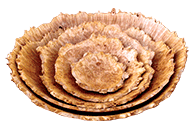Easy-Core Coring System
(more information)
Insights on Design
By stepping completely outside the envelope, we have produced a Coring System that is head and shoulders above the rest.
The first thing we committed to was fixing the arc that the knife could travel on. The fact is: a curved knife can only be fed through a matching curve. Varying the curve while coring by widening the groove just hides the existence of a narrow, exact matching curve. This does not restrain the position of the curve. Once the position of the curve is decided, the knife is fixed and can only cut the matching radius where the turner puts it. This makes it easy to use and also very flexible.
We also had to think about lathe stability and horsepower requirements. We didn't want our system to be restricted to ONEWAY lathe owners, we wanted to make it available to everyone with a reasonable sized lathe. It is common sense that coring shouldn't require an extremely heavy-duty lathe. A coring tool is a simple scraper, with a cutter that is 3/8" wide. Why should that require a huge lathe?
One problem with coring is vibration. Vibration while coring is not coming from the headstock being too weak or from the wood. It is caused because the knife is unsupported and usually very long. We solved that problem by supporting the knife inside the groove.
Another problem with coring is that it has traditionally required a large horsepower lathe. Horsepower is required because the groove often clogs with chips, which can happen for three reasons.
- The first is because some systems make it difficult to clear the chips. With the Easy Core System, chips can be easily cleared as often as required because the knife is completely restrained.
- The second reason coring can require a lot of horsepower is the knife rubbing on the sides of the bowl and core. This happens when turners using other systems try to make the knife cut a different curve than what the knife was designed for.
- A third problem is catches while deep inside the groove. The geometry of the cutter solves this problem.
 Innovative Cutter Geometry
Innovative Cutter Geometry
Cutter geometry was the most important breakthrough of this system.
While testing several of the first prototypes, everything would be working fine when suddenly the tool would catch. The problem is that it is impossible to see what's going on inside the groove, making it a difficult problem to solve.
It took months of intense thought, and a lot of trial and error. Finally, the solution hit. The cutter geometry should have a thin, very negative nose and slightly positive top. The thin negative nose prevents the tool from being pulled into the wood, keeps the side grain from peeling off and eliminates catches. Cutters will not grab or dig in.
 How does it work?
How does it work?
A heavy duty steel base plate attaches to the bed of the lathe. Two supports, one for the support finger and one for the cutter blade are attached to the base plate. The support finger and cutter blade fit into these supports. The position of the support is determined by the size of the blank being cored, and the wall thickness desired.
A tool handle is attached to the cutter blade and is used to introduce the cutter to the wood. This system has been designed in such a way that the tailstock can be used while coring. Using the tailstock in any wood turning operation greatly increases the safety factor.
When the entry cut is made, the support finger is positioned at the face of the bowl supporting the cutter blade.
The cutter is on a fixed arc and it becomes a simple matter of deepening the cut by exerting pressure with the handle. After progressing 2 - 3 inches into the groove, the cutter should be removed and the lathe stopped to re-position the support finger by introducing it into the groove. This procedure is continued until the knife reaches maximum depth. Tapping the edges of the core will break it lose, or it can be pried out with a minimal amount of force. Cores produced will have a smooth surface and be symmetrical.
| Quicklinks: Easy-Core Overview | |
| » 16", 20", 24" Swing | » 10" & 12" Swing |

Nested Set of Bowls
by David Lancaster
www.heirloombowls.com